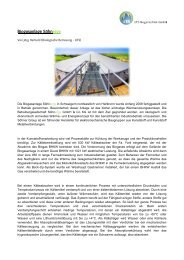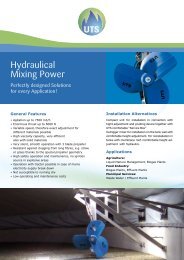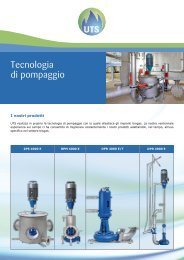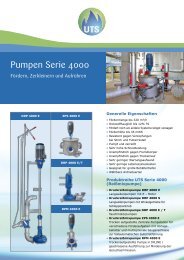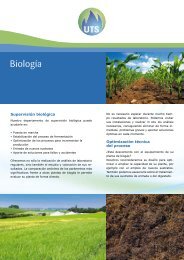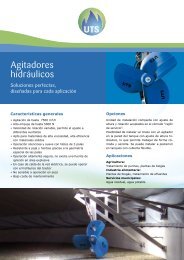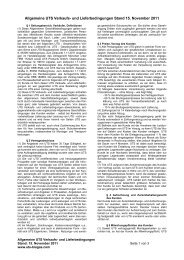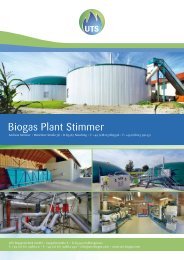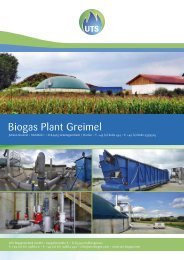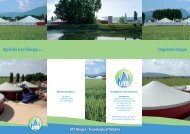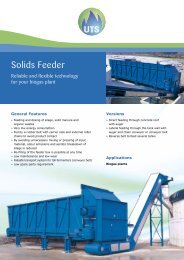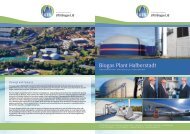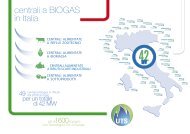Biogasanlage Söhnergy - UTS Biogas
Biogasanlage Söhnergy - UTS Biogas
Biogasanlage Söhnergy - UTS Biogas
You also want an ePaper? Increase the reach of your titles
YUMPU automatically turns print PDFs into web optimized ePapers that Google loves.
<strong>UTS</strong> <strong>Biogas</strong> Plant <strong>Söhnergy</strong><br />
by Jörg Herbold, Biological Service (<strong>UTS</strong> <strong>Biogas</strong>technik GmbH)<br />
The biogas plant <strong>Söhnergy</strong> in Schwaigern, northwest of Heilbronn, was completed and put into operation in<br />
early 2008. The feature of this system is the unprecedented heat utilisation concept. The operating company<br />
<strong>Söhnergy</strong> GmbH & Co KG was founded with the goal of an ecologically and economically sensible heat and<br />
energy concept for the neighbouring industrial site. Söhner Group is a leading manufacturer of<br />
electromechanical assemblies made from plastic as well as of plastic metal compounds.<br />
In polymer processing much process cold is required to cool the tools and the production facilities. In order to<br />
provide the process cold, a 630 kW cold absorber from the company York is used which is being operated<br />
with the waste heat of the biogas CHP. The conversion of the biogas into electricity happens at the site of<br />
the biogas plant in a Deutz CHP with 1021 kW of electric power. The accruing heat is then led through a 950<br />
m long district heating pipe to the industrial plant. Only the heat of the gas mixing cooler is used to heat the<br />
fermenter and the secondary fermenter so that the full heat of the waste gas heat exchanger and enginecooling<br />
circuit of the CHP can be released into the district heating pipe. A Weishaupt gas burner was<br />
installed as a back-up system, which processes the gas providing the required heat in case the CHP should<br />
be out of service.<br />
In a cold absorber, a refrigerant is vaporised in a continuous process with different pressure and temperature<br />
levels, and absorbed by a solution low in refrigerants. By leading the refrigerant through a second<br />
evaporation stage, and using external heat, the refrigerant is again separated from the solution and then<br />
liquefied. The system is based on the ability of some materials to absorb other substances well and to<br />
release them under different conditions. As a result the whole process operates at three different<br />
temperatures and two different pressure levels. With the first stage of evaporation low temperatures occur,<br />
with which a cooling medium is cooled. The two mediums used are ammonia and water with potential<br />
temperatures of up to -60°C or water and a bromide lithium solution with up to +4°C. Water, or a cooling<br />
brine, is used as a cooling medium. With absorption refrigeration systems the solvent can be compared with<br />
mechanical refrigeration. In the case of mechanical cooling aggregates, the resulting refrigerant vapours are<br />
sucked through a compressor. With the absorption cooling system, the hygroscopic solvent absorbing the<br />
cooling medium acts as an absorbent.<br />
100319 <strong>Söhnergy</strong> Article_ENG.docx / 1<br />
© <strong>UTS</strong> <strong>Biogas</strong>technik GmbH 02/2010
On 3 rd March 2008 the trial operation of the biogas plant was started. Since early July 2008 the plant has<br />
been running at full load. Renewable raw material is used exclusively as the fermentation substrate, mainly<br />
corn silage, rye and triticale as whole crop silage and sudan grass and sweet sorghum. The harvested<br />
energy crops are stored in specially constructed silage clamps on the site. The crops are grown by 44<br />
farmers from the surrounding area. Controlled by a GPS system on the forage harvesters and transport<br />
vehicles, the harvest of each field can be assigned. By weighing and determining the dry matter of each<br />
individual load, an exact accounting of the individual farmers can be ensured.<br />
Once a day the required amount of raw material is taken from the silage clamp<br />
and loaded in the Havelberger solids feeder with a loading volume of 80 m³.<br />
This machine feeds the material in 48 batches per day via a conveyor belt and<br />
feeding augers directly into the fermenter. The dosing station is placed on<br />
weighing bars, so that an accurate record and control of the input solids is<br />
guaranteed.<br />
The biogas plant is designed so that the two fermenters of about 1800 m³<br />
reactor volume each are directly fed in parallel. The secondary fermenter is<br />
positioned downstream with about 3300 m³ reactor volume. The partially<br />
fermented material is brought into the secondary fermenter from the primary<br />
fermenter, without any further expenditure of energy, through a special<br />
overflow. The secondary fermenter ensures that even the partially fermented material from the primary<br />
fermenters is processed completely. Through this two-stage process, the input material is effectively used<br />
and achieves about 35% higher gas yields than the expectations according to KTBL information. This<br />
exceptional performance of the organic conversion is achieved by the feeding/mixing technology, the overall<br />
process control as well as the generously measured fermentation tanks thus providing a long retention time.<br />
For the mixing of the substrate in the fermenter two submersible hydraulic mixers are used. The hydraulic<br />
drive has several major advantages: the high torque at low revolutions, the EX-protection and the excellent<br />
heat dissipation through the externally located hydraulic aggregates. Thus, the efficiency of the mixers in the<br />
highly viscous and warm biogas substrate remains constant - in contrast to electrically driven submersible<br />
mixers. The mixers can be adjusted from the concrete roof of the digester through the service box in height<br />
and mixing direction. The patented <strong>UTS</strong> service boxes allow easy maintenance of the mixers during plant<br />
operation, without requiring the liquid level inside the fermenter to be lowered. The secondary fermenter is<br />
also equipped with two submersible hydraulic mixers. The final storage is equipped with two electrical<br />
submersible mixers due to the low mixing requirements and low temperatures. The hydraulic aggregates to<br />
operate the mixers are housed in the central pump building. This guarantees good heat dissipation and short<br />
distances for hydraulic pipes.<br />
In automatic mode, the thinner substrate from the secondary fermenter is recirculated back into the primary<br />
fermenters. The <strong>UTS</strong> piping and pumping design has all fermenters connected with each other, so that<br />
balancing, exchanges and dilutions are all possible if and when required.<br />
100319 <strong>Söhnergy</strong> Article_ENG.docx / 2<br />
© <strong>UTS</strong> <strong>Biogas</strong>technik GmbH 02/2010
The pump building is spaciously designed and easily accessible for<br />
maintenance. The central pump station and distribution of the substrate<br />
are housed in this building. This makes it possible to pump from one<br />
fermenter to the other. The integrated flow measurement and pneumatic<br />
valves allow an automated pump operation. The control system of the<br />
biogas plant is also placed in the pump building. It monitors and<br />
regulates liquid levels, temperatures, mixing and pumping operations. All<br />
procedures, except for the filling of the dosing station, are automated.<br />
The entire control system can be controlled by a PC in the CHP building.<br />
Through a data connection, the operators of the plant have access to the<br />
authorised remote monitoring allowing them to have external access to<br />
the controls of the biogas plant. This allows the operators of the plant to<br />
observe the system at any time. The remote monitoring also allows <strong>UTS</strong><br />
experts to eliminate possible errors or provide assistance in operating the<br />
plant correctly. Of course, a function to automatically call the operators in cases of emergency is installed to<br />
inform them and allow them to react in time.<br />
A final storage tank of 4400 m³ was built to store the fermented material. Like the secondary fermenter, it is<br />
covered with a gastight tent roof. The resulting gas storage space is used as a buffer for the gas production<br />
and it also provides a large space for the biological desulphurisation. The biological desulphurisation with a<br />
dosed air input allows <strong>UTS</strong> not to rely on any chemical addition such as iron supplements which are often<br />
used with high hydrogen sulphide content materials.<br />
The biogas produced in the primary fermenters is led into the gas storage of the secondary fermenter and<br />
the repository tank via stainless steel pipes installed above ground. There is the option to operate each<br />
fermenter independently or lead a gas mixture of all fermenters to the CHP. To monitor the gas quality and<br />
the automated control of the air entry for the desulphurisation, a continuous gas analyser is integrated.<br />
The solids from the fermentation residues can be mechanically separated by a separator in a liquid and solid<br />
fraction. A proportion of the solid residue is fed into the plant again for fermentation, via the solids feeder, to<br />
increase the substrate utilisation. Nevertheless the majority of the solid residue is delivered to composting<br />
which creates a high quality plant substrate. Another possibility of use is to use the pressed residues after<br />
drying as a fuel in pellet form.<br />
To have the plant quickly and reliably run on full output, the experts of <strong>UTS</strong> created a special schedule. This<br />
includes data of how to increase the input material in a certain period of time. In March 2008, the plant<br />
operators began to “feed” the fermenters, and after three months the contractually guaranteed power input<br />
was already reached. When increasing the feeding, it is important to note that the fermenters should not be<br />
overfed. If more substrate is fed than the bacteria can convert into biogas, the fermenters suffer from<br />
hyperacidity and as a result the infamous “crash” of the plant can occur. To avoid this problem, the experts of<br />
<strong>UTS</strong> have samples from the substrate analysed in a laboratory in regular intervals.<br />
100319 <strong>Söhnergy</strong> Article_ENG.docx / 3<br />
© <strong>UTS</strong> <strong>Biogas</strong>technik GmbH 02/2010
These samples are analysed for the content of organic acids and their composition, the percentage of<br />
organic solids, the ammonium nitrogen content and the supply of trace nutrients. In addition, one of the <strong>UTS</strong><br />
experts visits the plant in the start-up phase every 14 days. On site some rapid tests are conducted and all<br />
important parameters of the biogas production are controlled.<br />
Through a balanced strategy during the start-up phase, <strong>UTS</strong> can reliably and sustainably ensure that the<br />
biogas plant will reach the planned power output as quickly as possible. It is important to monitor and control<br />
the start-up since lots of money could be wasted during this period of time. If the plant is taken to full power<br />
too slowly, the potential revenue from feeding into the power grid is lowered. If the operators try to bring the<br />
plant to maximum output too fast, the biology may be disrupted by overfed fermenters. The overload of the<br />
biological process leads to problems often resulting in delay of performance for weeks and thus causes high<br />
costs/losses. The perfect start-up phase can only be achieved by an optimal feeding of the fermenters and<br />
comprehensive process monitoring.<br />
The reliable and competent support of the plant, efficient and reliable technology and high performance<br />
biology with optimal use of substrates guarantee a successful operation of the plant. In combination with a<br />
reasonable heat concept, a biogas plant also pays for itself with high-price substrates.<br />
For more information on reliable biogas technology, please visit www.uts-biogas.com<br />
100319 <strong>Söhnergy</strong> Article_ENG.docx / 4<br />
© <strong>UTS</strong> <strong>Biogas</strong>technik GmbH 02/2010



